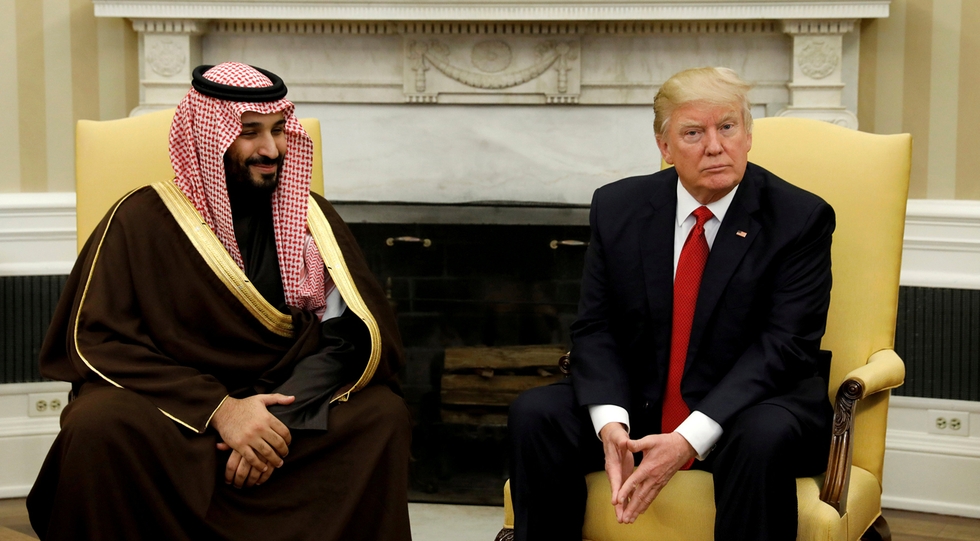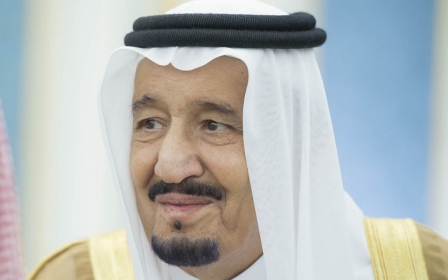ANALYSIS: What Trump can learn from previous US presidents' Mideast visits

NEW YORK, United States – US presidents tend to either sink or swim during forays to the Middle East.
So when the current commander-in-chief, Donald Trump, boards Air Force One for his first foreign presidential venture to Saudi Arabia on Thursday, he may benefit from a recap of his predecessors’ hits and misses in the demanding region.
Former President Franklin D. Roosevelt set the bar high when he feted the first Saudi King, Abdul Aziz ibn Saud, aboard the USS Quincy in the Suez Canal’s Bitter Lake in 1945, brokering a security-for-oil deal that has weathered decades.
Others have taken diplomatic belly flops. Richard Nixon’s Middle East tour of 1974 did little to shake off the Watergate crisis. An angry Iraqi journalist threw his shoes at George W. Bush over the devastation of his country in 2008.
But the most recent comparison is Barack Obama, who swung by Riyadh en route to Cairo and a landmark June 2009 speech on unpicking cultural clashes between western and Muslim nations and redressing “decades of mistrust” with Iran.
Saudi Arabia as Islam's centre?
Analysts remain divided on whether Obama’s July 2015 nuclear pact with Tehran made the Middle East any safer or just postponed the perils of revolutionary mullahs toting nuclear-tipped missiles around the region.
What is certain is that Sunni neighbours and Israel were not best pleased. Israelis railed against Obama’s dealmaking with Tehran while Saudi Arabia’s King Salman stiffed Obama by avoiding his May 2015 security talks in Washington.
According to Vali Nasr, a US State Department advisor, Trump’s choice of Riyadh for his first foreign foray – while at odds with his campaign-trail aspersions on the desert kingdom – marks a deliberate shift from the Obama era.
“Trump decided that it’s Saudi Arabia rather than Egypt that is the centre of Islam. So he is going to engage the Muslim world in Saudi Arabia rather than Cairo, which is where President Obama started his engagement,” Nasr told Middle East Eye.
It likely also influenced Trump’s 22 May touchdown in Israel too, said Robert Danin, 20-year State Department veteran.
“On his first trip to the Middle East, President Obama did not stop in Israel, and this was a slight that the Israelis did not forget for eight years,” Danin told MEE.
Mideast trips by previous administrations
When President George W. Bush first swung through Egypt, Jordan and Qatar in June 2003, the US invasion of Iraq was still being touted as a heroic bid to oust a tyrannical Saddam Hussein and rid his arsenals of mass-casualty weapons.
By the time Bush met Iraqi leaders for security talks in December 2008, it was abundantly clear that the neoconservatives’ effort at nation-building a modern democracy in Iraq had deviated massively from the poorly hatched plans.
Iraqi TV journalist Muntazer al-Zaidi thought so too. The angry reporter threw both his shoes at Bush and called him a dog during a press conference with Prime Minister Nuri al-Maliki. Though Bush was not injured, the snub left bruising tread-marks on an increasingly unpopular leader.
By contrast, the previous presidency of Bill Clinton resembles a halcyon era – years of sustained economic growth that were sandwiched between the collapse of the Soviet Union and the 9/11 attacks. Compared to now, the Middle East had the stability of strongmen and petro-royals.
Early in his presidency in October 1994, Clinton attended the signing of the Israel-Jordan Peace Treaty on the border between the two nations. The Arkansas lawyer continued visiting for peace talks, including Israeli-Palestinian negotiations in Sharm el-Sheikh, Egypt, in October 2000.
Earlier that year, he had hosted Israeli Prime Minister Ehud Barak and Palestinian leader Yasser Arafat for talks on ending decades of violence. No deal was agreed, but Clinton came closer to the Holy Grail of peace treaties than other US presidents.
George H.W. Bush’s one-term presidency also has the look of simpler times. In November 1990, he visited Saudi Arabia to celebrate Thanksgiving with American troops stationed there with the blessing of both Riyadh and the international community.
By the end of that month, the United Nations Security Council had voted to authorise the use of force against Iraq if it did not withdraw its troops from Kuwait. The next year, Operation Desert Storm decisively ended Saddam’s Gulf expansion plans.
Ronald Reagan was busy ending the Cold War and never visited the Middle East while in office.
Jimmy Carter frequented the region for peace talks that ended in a March 1979 White House ceremony in which Israeli Prime Minister Menachem Begin and Egyptian President Anwar Sadat inked the first peace deal between Israelis and Arabs.
Trump's trip oddly Nixonian?
Perhaps the closest comparison to Trump’s upcoming trip is Nixon’s tour of Egypt, Saudi Arabia, Syria, Israel and Jordan in June 1974.
Just as Trump is getting away from a Washington swirling with allegations that his campaign staff colluded with Kremlin-backed hackers, Nixon’s visit occurred against the backdrop of the Watergate scandal.
According to Bruce Riedel, a 30-year Central Intelligence Agency veteran, Nixon was “desperate for a big diplomatic deal” with Saudi Arabia’s King Faisal in the wake of the 1973 Arab-Israeli war “to save him from impeachment” back home.
The royal did not oblige and Nixon “left empty-handed”, added Riedel. He resigned two months later.
Trump doubtless wants to direct US media attention from round-the-clock coverage of his recent sacking of FBI director James Comey. It is not yet clear whether his meets with Saudis, Israelis, Palestinians and others will alter the punishing headlines.
For Elliott Abrams, a deputy national security advisor in George W. Bush’s administration, presidential “trips are symbolic”. Like other US leaders in the Middle East, Trump will be feted and cheered, most action will take place behind closed doors and little will be revealed.
“Major decisions are not made in trips, they are made before them. The trip is an action-forcing device to get all the ducks in line, to make sure answers to questions are in-hand prior to getting on the plane,” Abrams told MEE.
“These trips are more important in establishing or changing personal relationships than they are in setting the major decisions of American foreign policy.”
New MEE newsletter: Jerusalem Dispatch
Sign up to get the latest insights and analysis on Israel-Palestine, alongside Turkey Unpacked and other MEE newsletters
Middle East Eye delivers independent and unrivalled coverage and analysis of the Middle East, North Africa and beyond. To learn more about republishing this content and the associated fees, please fill out this form. More about MEE can be found here.





